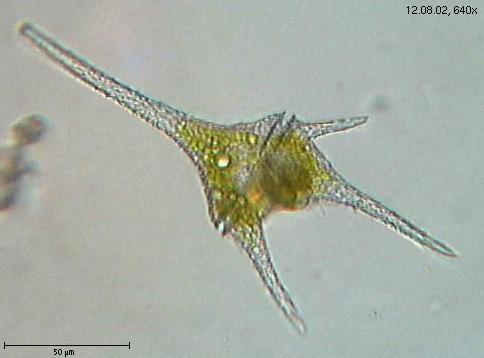- Bikont
Taxobox
color = #taxobox colour|incertae sedis
name = Bikonts

image_caption = "Ceratium hirundinella "
domain = Eukaryota
subdivision_ranks = Supergroups
subdivision =Apusozoa Rhizaria Excavata Archaeplastida Chromalveolata
A Bikont ("two flagella") is a eukaryotic cell with twoflagella , as its name suggests. Another shared trait of bikonts is the fusion of twogene s into a single unit: the genes for thymidylate synthase (TS) and dihydrofolate reductase (DHFR) encode a singleprotein with two functions (Cavalier-Smith, 2006). The genes are separately translated in unikonts.Some research suggests that a
unikont (a eukaryotic cell with a single flagellum) was the ancestor ofopisthokonts (Animals, Fungi and related forms) andAmoebozoa , and a bikont was the ancestor ofArchaeplastida (Plants and relatives),Excavata ,Rhizaria , and Chromalveolata.Cavalier-Smith has suggested thatApusozoa , which are typically considered "incertae sedis ", are in fact bikonts.Relationships within the bikonts are not yet clear. Cavalier-Smith has grouped the Excavata and Rhizaria into the
Cabozoa and the Archaeplastida and Chromalveolata into theCorticata , but at least one other study has suggested that the Rhizaria and Chromalveolata form a clade. [cite journal | author = Burki F, Shalchian-Tabrizi K, Minge M, Skjæveland Å, Nikolaev SI, et al. | year = 2007 | title = Phylogenomics Reshuffles the Eukaryotic Supergroups | journal = PLoS ONE | volume = 2 | issue = 8: e790 | doi = 10.1371/journal.pone.0000790 | pages = e790]References
* cite journal
author=Thomas Cavalier-Smith
title=Protist phylogeny and the high-level classification of Protozoa
journal=European Journal of Protistology
year=2006 | volume=39 | issue=4 |pages=338–348
doi=10.1078/0932-4739-00002* cite journal
author=Alexandra Stechmann and Thomas Cavalier-Smith
title=The root of the eukaryote tree pinpointed
journal=Current Biology
year=2003 | volume=13 | issue=17
Wikimedia Foundation. 2010.
